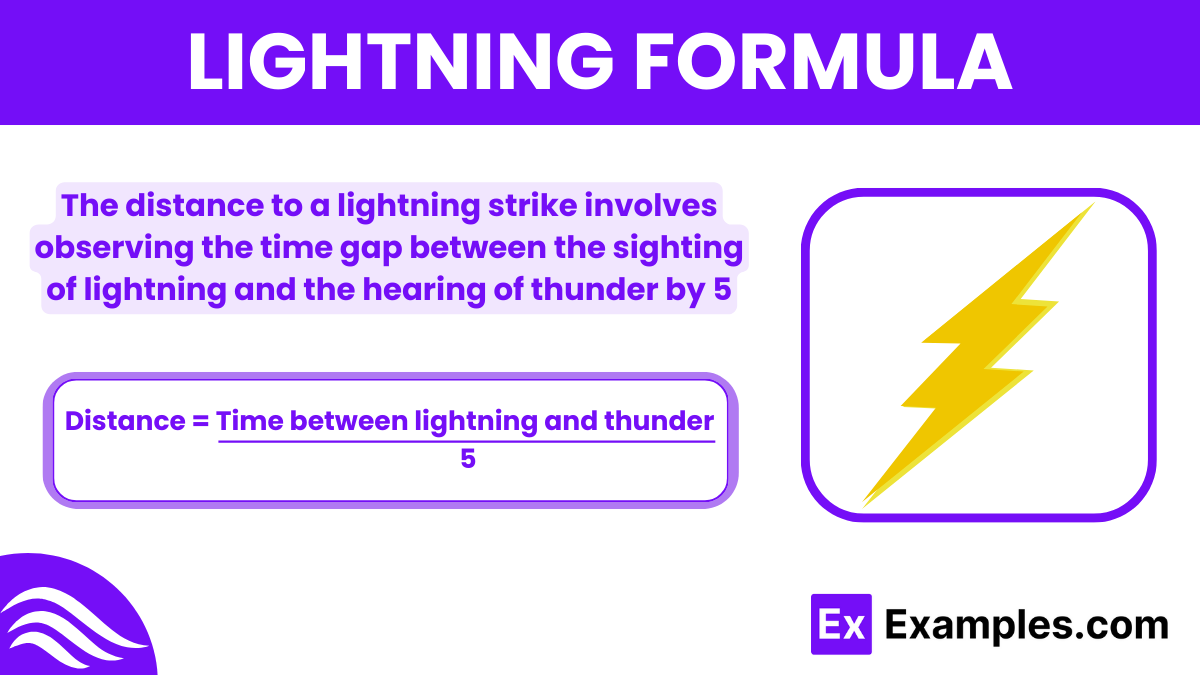What is the formula to calculate the energy released by a lightning bolt?
E = mc²
E = VIt
E = ½mv²
E = kQq/r²


Lightning represents a powerful natural electrostatic discharge where two electrically charged regions in the atmosphere or between the atmosphere and the ground temporarily equalize themselves, causing the release of as much as one gigajoule of energy. This physics phenomenon manifests as a bright flash and thunder that can be both awe-inspiring and frightening.
The formula to estimate the distance to a lightning strike involves observing the time gap between the sighting of lightning and the hearing of thunder. We calculate it using the speed of sound in air, given by the formula:
To derive this formula, we take into account that sound travels at about 340 meters per second in air, which is approximately 1,125 feet per second. This translates to about 5 seconds per mile. So, when you see lightning and start counting the seconds until you hear thunder, every five seconds represents about one mile in distance.
Benjamin Franklin, an American polymath, famously discovered the electrical nature of lightning through his kite experiment in 1752. By flying a kite during a thunderstorm, Franklin demonstrated that lightning and tiny electric sparks were the same phenomenon, laying the groundwork for the development of the lightning rod to protect buildings from damage.
Problem: You see lightning and start counting until you hear thunder. You count 15 seconds. How far away is the lightning strike?
Solution: Use the formula: Distance = Time / 5
Distance=15 seconds / 5=3 miles
The lightning strike is 3 miles away.
Problem: If a lightning strike occurs 2 miles away, how long will it take for you to hear the thunder?
Solution: Use the formula: Time= Distance × 5
Time=2 miles×5=10 seconds
You will hear thunder 10 seconds after seeing the lightning.
Problem: You initially hear thunder 30 seconds after seeing lightning. Five minutes later, the time interval decreases to 15 seconds. Is the storm moving towards you or away from you?
Solution: Calculate the initial distance:
Distance=30 seconds / 5=6 miles
Calculate the later distance: Distance=15 seconds / 5=3 miles
Since the distance decreased from 6 miles to 3 miles, the storm is moving towards you.
Yes, scientists can artificially create lightning using large electrical charges to simulate the natural conditions that cause lightning.
Lightning is primarily a physics phenomenon, involving the movement and interaction of electrical charges in the atmosphere.
Lightning helps purify the air by producing ozone and other chemicals that can break down pollutants.
Text prompt
Add Tone
10 Examples of Public speaking
20 Examples of Gas lighting
What is the formula to calculate the energy released by a lightning bolt?
E = mc²
E = VIt
E = ½mv²
E = kQq/r²
Which formula represents the electric field strength of a lightning bolt?
E = kQ/r²
E = F/q
E = V/d
E = IR
If the voltage of a lightning bolt is 1,000,000 volts and the current is 30,000 amperes, how much energy is released in 0.1 seconds?
3,000,000 J
30,000,000 J
300,000,000 J
3,000 J
What unit is used to measure the current of a lightning bolt?
Volts
Amperes
Joules
Ohms
What physical quantity does the formula E = VIt calculate in the context of lightning?
Voltage
Energy
Power
Resistance
How is the power of a lightning bolt related to the energy and time?
P = E/t
P = E*t
P = E²/t
P = E/t²
What happens to the energy of a lightning bolt if the voltage is doubled and the current remains constant?
It remains the same
It is halved
It doubles
It quadruples
What is the primary cause of lightning?
Differences in atmospheric pressure
Differences in electric potentia
Differences in temperature
Differences in humidity
How is the speed of light related to lightning?
It determines the brightness of lightning
It determines the duration of lightning
It determines the travel time of the flash
It determines the energy of lightning
What unit is used to measure the voltage of a lightning bolt?
Joules
Watts
Volts
Amperes
Before you leave, take our quick quiz to enhance your learning!

